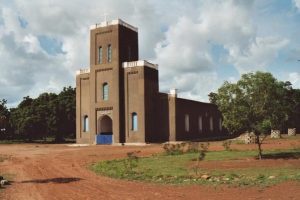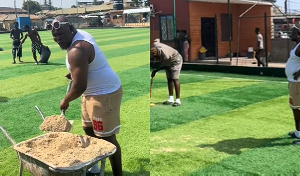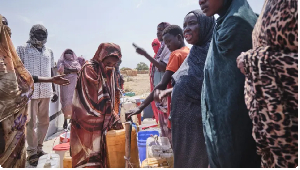Little is known of the history of the ancestors of Navrongo, the Gurunsi. According to oral tradition the Gurunsi originally came from the western Sudan passing through the Sahel. Their presence was not recorded until the Mossi people moved North around the 1500, from the northern region of present-day Ghana, to create the various Mossi kingdoms. Diverse accounts relate the numerous incursions by the Mossi into the area to sack the villages and capture slaves for sale. Thanks to their fierce resistance the ancestors of the Gurunsi escaped the domination of the Mossi kingdom. The Gurunsi territories remained, however, for many years, the theater of unceasing wars, wars of conquest first, which became pillaging operations after the Mossi had forgone their attempts to establish supremacy over the Gurunsi territories. The historical background of the Gurunsi brings into relief two essential attributes: their spirit of independence and their capacity of defense. It was these wars and the search for better hunting grounds that pressed some Gurunsi people to settle around the present day town of Zecco in Ghana’s northern neighbor, Burkina Faso.
The story of Navrongo begins with the travels of three brothers from Zecco: Butto (oldest), Zakato, and Sule (youngest). From the town of Zecco the three brothers set out to find better hunting. After traveling for a few days they came across a new small village called Telania (NW of present day Navrongo). The three brothers from Zecco were Nankani speakers while the Telania people were Kasem speakers. Today both languages are used in the Navrongo area. The Telania people originated from the village of Tielebe which is now in Burkina Faso, twenty miles to the North. The three brothers befriended the Telania people and stayed with them for some time. They exchanged their expertise with one another: Butto and his brothers taking farming techniques and the Telania people taking architecture.
One day Butto went out for hunting in a new area and found that the ground was soft. When he returned to his brothers he said, “I’ve found a place were the ground is soft on the foot.” The place then took on the name Na-Voro (Naga (foot) + Voro (soft)). Na-voro is still the named used by its inhabitants while Navrongo is used as an English translation. Butto went back to the area and settled about a 1/4 mile south of present day Notre Dame Secondary School. The remains of his house can still be seen today. The two brothers, Zakato and Sule, remained with the Telania people for sometime.
During one of Butto’s hunting trips he came across a grove of trees and rocks that reminded him of his ancestral shrine of Zecco. In African traditional religion a grove of trees can sometimes be an ancestral shrines. For Butto it seemed that his father’s shrine had followed him to Na-voro. He decided to move near to the shrine. This site is now home of present day Navrongo Chief’s compound.
The land was well suited to farming and hunting and the people of Na-voro and the surrounding areas prospered and grew despite slave raiding expeditions. A particularly feared slave raider was Babatu Zato (1850?-?) who devastated the area. All villages who wished to avoid Babatu’s raids had to pay heavy tributes in cowries, cattle, and even horses. In 1896 French troops led by Lieutenants Voulet and Chanoine intervened at the request of Hamaria, a Gurunsi leader. Babatu was driven southward to the vicinity of Wa, Ghana.
In 1901 a British expedition camped ten miles south of Navrongo near a small village called Vanania. People in the surrounding villages thought that the expedition force was Babatu and his men. Babatu was considered a fair-skinned African and was described as a “fela”, Kasem for white-person. The Navrongo chief, Kwara, beat the gong-gong and told everyone that the “fela” have camped on the Vanania hill called “Tinu”. A small group of men attacked but soon resigned after the people realized that their weapons were no match for the guns of the British. The British expedition force then settled near the Kwara’s house in Navrongo. The British forces offered Navrongo protection from slave raiders and Kwara accepted. Due to the British influence the role of the Chief took on more importance within the Navrongo community. But the “tegetu”, the spiritual landlord, still today remains a powerful authority figure.
On April 23, 1906 Canadian French Fathers Morin and Chollet and Brother Eugene arrived at the English military quarters of Navrongo with the intention of establishing a Catholic mission station there under the name of Our Lady of Seven Sorrows. The missionary group had traveled over one hundred miles on foot from the town of Ouagadougou, which is the present day capital of Burkina Faso. A small hut was built in June of that year. This hut was replaced soon after by a larger rectangular flat roofed building with arched windows and doors. In 1920 a new larger chapel, with simple colonnaded interior divided into nave and side aisles, was erected. This was latter dedicated as a cathedral in 1934 and as the Mother Parish of all the parishes in Northern Ghana.
After Ghana’s independence from British colonial rule in 1957, Navrongo became the district capital for the Kassena/Nankani district.
Opinions of Thursday, 16 June 2016
Columnist: northerngh















